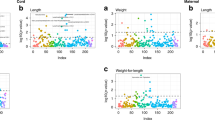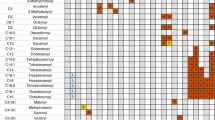Abstract
Despite a number of published reports, there is limited information about carnitine metabolism in the newborn. To establish normative data, we analyzed whole-blood carnitine concentrations in 24,644 newborns at age 1.85 ± 0.95 d and umbilical cord whole blood and plasma carnitine concentrations in 50 full-term newborns. Total carnitine (TC), free carnitine (FC), and acylcarnitine (AC) were measured by electrospray tandem mass spectrometry. AC/FC ratios were derived from these measurements. The entire cohort was stratified according to TC values into a middle TC group representing 90% of the population and lower and upper TC groups representing 5% of the population, respectively. Normative data were derived from the middle TC group of full-term infants (N = 19,595). TC was 72.42 ± 20.75 μM, FC was 44.94 ± 14.99 μM, AC was 27.48 ± 8.05 μM, and AC/FC ratio was 0.64 ± 0.19 (±SD). These values differed significantly from umbilical cord whole blood TC values of 31.27 ± 10.54 μM determined in 50 samples. No meaningful correlation was found between TC and gestational age or birth weight in any group. In controlled analyses, prematurity was not associated with TC levels, whereas low birth weight (<2500 g) and male sex were significantly associated with higher TC levels. The association of low birth weight with higher TC values may be related to decreased tissue carnitine uptake. The sex effect may be related to hormonal influences on carnitine metabolism. Our study provides normative data of carnitine values measured by the highly precise method of electrospray tandem mass spectrometry in a large cohort of newborns and provides the basis for future studies of carnitine metabolism in health and disease states during the neonatal period.
Similar content being viewed by others
Log in or create a free account to read this content
Gain free access to this article, as well as selected content from this journal and more on nature.com
or
Abbreviations
- MS-MS:
-
electrospray tandem mass spectrometry
- TC:
-
total carnitine
- FC:
-
free carnitine
- AC:
-
acylcarnitine
- RBC:
-
red blood cells
- OR:
-
Odds ratio
- CI:
-
95% confidence interval
- RE:
-
radioenzyme
References
Pons R, De Vivo DC 1995 Primary and secondary carnitine deficiency syndromes. J Child Neurol 10( suppl): 2S8–2S24
Bremer J 1983 Carnitine: metabolism and functions. Physiol Rev 63: 1420–1449
Warshaw JB, Curry E 1980 Comparison of serum carnitine and ketone body concentration in breast- and in formula-fed newborn infants. J Pediatr 97: 122–125
Schimdt-Sommerfeld E, Penn D, Sodha RJ, Progler M, Novak M, Schneider H 1985 Transfer and metabolism of carnitine esters in the in vitro perfused human placenta. Pediatr Res 19: 700–706
Girard J, Ferre P, Pegorier JP, Duee PH 1992 Adaptations of glucose and fatty acid metabolism during perinatal period and suckling-weaning transition. Physiol Rev 72: 507–562
Arenas J, Rubio JC, Martin MA, Campos Y 1998 Biological roles of L-carnitine in perinatal metabolism. Early Hum Dev 53 ( suppl) S43–S50
Novack M, Monkus EF, Chung D, Buch M 1981 Carnitine in the perinatal metabolism of lipids. I. Relationship between maternal and fetal plasma levels of carnitine and acylcarnitines. Pediatrics 67: 95–100
Schimdt-Sommerfeld E, Penn D, Wolf H 1981 The influence of maternal fat metabolism on fetal carnitine levels. Early Hum Dev 5: 233–242
Borum PR 1995 Carnitine in neonatal nutrition. J Child Neurol 10( suppl): 2S25–2S31
Rebouche CJ 1992 Carnitine function and requirements during the life cycle. FASEB J 6: 3379–3386
Campoy C, Bayes R, Peinado JM, Rivero M, Lopez C, Molina-Font JA 1998 Evaluation of carnitine nutritional status in full-term newborn infants. Early Hum Dev 53( suppl): S149–S164
Rebouche CJ, Engel AG 1980 Significance of renal gamma-butyrobetaine hydroxylase for carnitine biosynthesis in man. J Biol Chem 255: 8700–8705
Bohles HJ, Evangeliou A, Bervoets K, Eckert S, Sewell A 1994 Carnitine esters in metabolic disease. Eur J Pediatr 153( suppl 1): S57–S61
Sewell AC, Bohles HJ 1995 Acylcarnitines in intermediary metabolism. Eur J Pediatr 154: 871–877
Borum PR 1985 Role of carnitine during development. Can J Physiol Pharmacol 63: 571–576
Battistella PA, Vergani L, Donzelli F, Rubaltelli F, Angelini C 1980 Plasma and urine carnitine levels during development. Pediatr Res 14: 1379–1381
Shenai JP, Borum PR, Mohan P, Donlevy C 1983 Carnitine status at birth of newborn infants of varying gestation. Pediatr Res 17: 579–582
Cederblad G, Niklasson A, Rydgren B, Altbertsson-Wikland K, Olegard R 1985 Carnitine in maternal and neonatal plasma. Acta Pediatr Scand 74: 500–504
Schimdt-Sommerfeld E, Werner D, Penn D 1988 Carnitine plasma concentrations in 353 metabolically healthy children. Eur J Pediatr 147: 356–360
Sachan DS, Smith RB, Plattsmier J, Lorch V 1989 Maternal cord, and neonatal carnitine correlations and lipid profiles of various birth weight infants. Am J Perinatol 6: 14–17
Milana A, Mazzone D 1995 Aspetti peculiari della carnitina nel periodo neonatale. Clin Ter 146: 21–29
Schoderbeck M, Auer B, Legenstein E, Genger H, Sevelda P, Salzer H, Marz R, Lohninger A 1995 Pregnancy-related changes of carnitine and acylcarnitine concentration of plasma and erythrocytes. J Perinat Med 23: 477–485
Giannacopoulou Ch, Evangeliou A, Matalliotakis I, Relakis K, Sbirakis N, Hatzidaki E, Koumandakis E 1998 Effects of gestation age and of birth weight in the concentration of carnitine in umbilical plasma. Clin Exp Obstet Gynecol 25: 42–45
Meyburg J, Shulze A, Kohlmueller D, Linderkamo O, Mayatepek E 2001 Postnatal changes in neonatal acylcarnitine profile. Pediatr Res 49: 125–129
Wilcken B, Wiley V, Sim KG, Carpenter K 2001 Carnitine transporter defect diagnosed by newborn screening with electrospray tandem mass spectrometry. J Pediatr 138: 581–584
Novack M, Wieser PB, Buch M, Hahn P 1979 Acetylcarnitine and free carnitine in body fluids before and after birth. Pediatr Res 13: 10–15
Chace DH, Hillman SL, Van Hove JLK, Naylor E 1997 Rapid diagnosis of MCAD deficiency: quantitative analysis of octanoylcarnitine and other acylcarnitines in newborn blood spots by tandem mass spectrometry. Clin Chem 43: 2106–2113
Chace DH, DiPerna JC, Mitchell Brenda L, Sgrol B, Hofman LF, Naylor EW 2001 Electrospray tandem mass spectrometry for analysis of acylcarnitines in dried postmortem blood specimens collected at autopsy from infants with unexplained cause of death. Clin Chem 47: 1166–1182
McGarry JD, Foster DW 1976 An improved and simplified radioisotopic assay for the determination of free and esterified carnitine. J Lipid Res 17: 277–281
Levy HL 1998 Newborn screening by tandem mass spectrometry: a new era. [editorial]. Clin Chem 44: 2401–2402
Bernardini I, Evans MI, Nicolaides KH, Economides DL, Gahl WA 1991 The fetal concentrating index as a gestational age-independent measure of placental dysfunction in intrauterine growth retardation. Am J Obstet Gynecol 164: 1481–1490
Wiley V, Carpenter K, Wilcken B 1999 Newborn screening with tandem mass spectrometry: 12 months experience in NSW Australia. Acta Paediatr Suppl 432: 48–51
Deufel T 1990 Determination of L-carnitine in biological fluids and tissues. J Clin Chem Clin Biochem 28: 307–311
Akisu M, Bekler C, Yalaz M, Huseyinov A, Kultursay N 2001 Free carnitine concentrations in cord blood in preterm and full-term infants with intrauterine growth retardation. Pediatr Int 43: 107–108
Cooper MB, Forte CA, Jones DA 1988 Carnitine and acetylcarnitine in red blood cells. Biochim Biophys Acta 959: 100–105
Cress AP, Fraker PJ, Bieber LL 1989 Carnitine and acylcarnitine levels of human peripheral blood lymphocytes and mononuclear phagocytes. Biochim Biophys Acta 992: 135–139
Hromadova M, Parrak V, Huttova M, Danova K, Urvolgyova M 1994 Carnitine level and several lipid parameters in venous blood of newborns, cord blood and maternal blood and milk. Endocr Regul 28: 47–52
Augenfeld J, Fritz IB 1970 Carnitine palmitoyltransferase activity and fatty acid oxidation by livers from fetal and neonatal rats. Can J Biochem 48: 288–294
Warshaw JB 1970 Cellular energy metabolism during fetal development. III Deficient acetyl-CoA synthetase, acetylcarnitine transferase and oxidation of acetate in the fetal bovine heart. Biochim Biophys Acta 223: 409–415
Ballard FJ 1971 Gluconeogenesis and the regulation of blood glucose in the neonate. In: Rodriguez RR, Valance-Owen J (eds) Diabetes. Excerpta Medica, Amsterdam, pp 592–600.
Hahn P, Skala JP 1975 The role of carnitine in brown adipose tissue of suckling rats. Comp Biochem Physiol B 51: 507–515
Dils RR, Parker DS 1982 Metabolic aspects of lactation and the supply of nutrients to the young In: Jones CT (ed) Biochemical Development of the Fetus and Neonate. Elsevier, Amsterdam, pp 573–590.
Girard J 1990 Metabolic adaptations to change of nutrition at birth. Biol Neonate 58( suppl 1): 3–15
De Vivo DC, Tein I, Reichmann H 1991 Idiosyncratic reactions to valproate: clinical risk patterns and mechanisms of toxicity. In: Levy RH, Penry JK (eds) Age Related Changes in Fatty Acid Oxidation. Raven Press, New York, pp 13–18.
French TJ, Goode AW, Sugden MC 1986 Blood carnitine concentrations are increased after surgical stress. Biochim Biophys Acta 882: 133–135
Borum PR 1978 Variation in tissue carnitine concentrations with age and sex in the rat. Biochem J 176: 677–681
Takiyama N, Matsumoto K 1998 Age- and sex-related differences of serum carnitine in a Japanese population. J Am Coll Nutr 17: 71–74
Cederblad G 1976 Plasma carnitine and body composition. Clin Chim Acta 67: 207–212
Shenai YP, Borum PR 1984 Tissue carnitine reserves of newborn infants. Pediatr Res 18: 670–681
Penn D, Ludwigs B, Schmidt-Sommerfeld E, Pascu F 1985 Effect of nutrition on tissue carnitine concentrations in infants of different gestational ages. Biol Neonate 47: 130–135
Acknowledgements
We thank Alice Kwan for data management and Drs. Piero Rinaldo, Salvatore DiMauro, and Leonidas Stefanis for critical comments during the conduct of these studies.
Author information
Authors and Affiliations
Corresponding author
Additional information
Supported in part by Sigma-Tau Pharmaceutical Inc. (Gaithersburg, MD), The Colleen Giblin Foundation for Pediatric Neurology Research, USPHS Grant RR 00645, and National Institutes of Health Grant RO1 DA11410.
Rights and permissions
About this article
Cite this article
Chace, D., Pons, R., Chiriboga, C. et al. Neonatal Blood Carnitine Concentrations: Normative Data by Electrospray Tandem Mass Spectometry. Pediatr Res 53, 823–829 (2003). https://doi.org/10.1203/01.PDR.0000059220.39578.3D
Received:
Accepted:
Issue date:
DOI: https://doi.org/10.1203/01.PDR.0000059220.39578.3D
This article is cited by
-
Instability of acylcarnitine and amino acids in dried blood spots preserved at various temperatures: the impact on retrospective analysis of inborn errors of metabolism biomarkers
Comparative Clinical Pathology (2024)
-
The role of carnitine in maintenance dialysis therapy
Pediatric Nephrology (2021)
-
Carnitine longitudinal pattern in preterm infants <1800 g body weight: a case–control study
Pediatric Research (2019)
-
Analysis and interpretation of acylcarnitine profiles in dried blood spot and plasma of preterm and full-term newborns
Pediatric Research (2015)
-
Postprandial changes of amino acid and acylcarnitine concentrations in dried blood samples
Journal of Inherited Metabolic Disease (2010)



